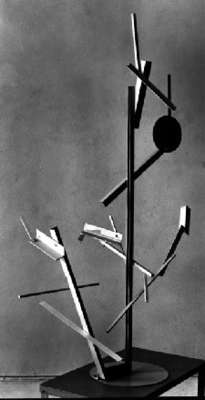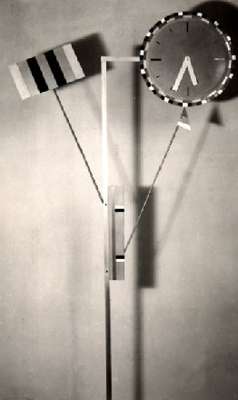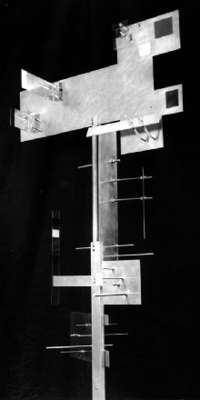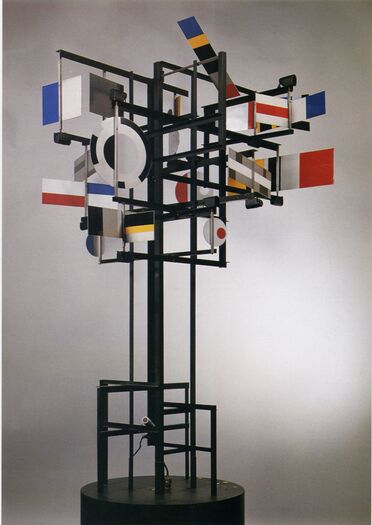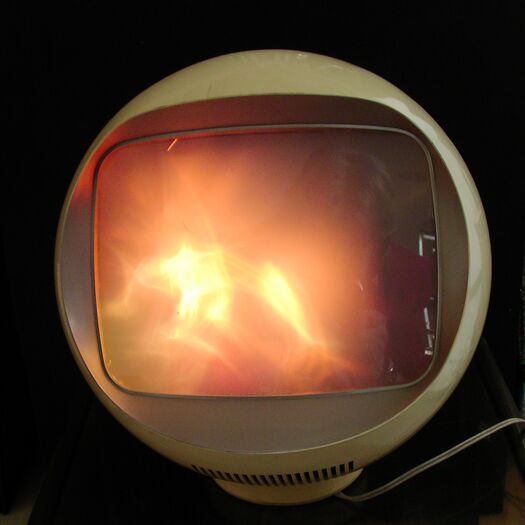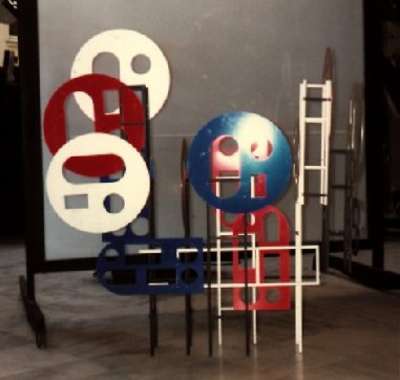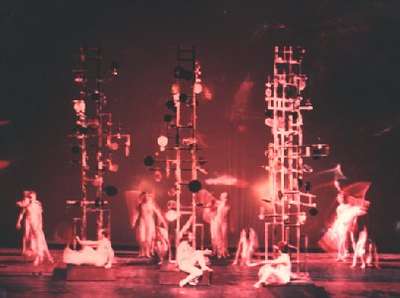Nicolas Schöffer
 | |
| Born |
September 6, 1912 Kalocsa, Hungary |
|---|---|
| Died |
January 8, 1992 (aged 79) Paris, France |
| Web | Wikipedia-FR, Wikipedia |
| Collections | Schöffer Museum 46, Pompidou 8, MNG Budapest 6, Albright-Knox 2, MAM Paris 1, Société Générale 1, Hirshhorn 1, Ludwig 1, JC Maldonado 1 |
Nicolas Schöffer (Schöffer Miklós) was a Hungarian-born visual artist who resided in France. He began pursuing his interest in integrating kinetic art with cybernetics in 1948. The computers which governed his sculptures’ “reactions” operated on the basis of feedback loops which allowed the artworks to automatically regulate their responses based on changes in their environment. Schöffer’s works challenged the traditional dichotomies between subject and object, artist and artwork. He claimed that his constructivist works provided abstract art with full autonomy to create itself. (Source)
Work[edit]
He was born in Kalocsa, Hungary and resided in Paris from 1936 till his death in his Montmartre atelier, Villa des Arts. His career touched on painting, kinetic sculpture, architecture, urbanism, film, TV, and music. Indeed he collaborated on music with Pierre Henry. All of the artistic actions of Schöffer were done in the pursuit of a dynamism in art.
This interest in artistic dynamism was originally initiated by the Cubo-Futurists and then intensified and solidified by the Constructivist artists, such as Naum Gabo, Antoine Pevsner, Laszlo Moholy-Nagy and Ludwig Hirschfeld-Mack, who were concerned with opening up the static three-dimensional sculptural form to a fourth dimension of time and motion. And this was the intention of Schöffer as well. In 1948 he began exploring spatio-dynamics, later in 1957 the luminodynamics (by integrating light, music, film), and since 1959 the element of time resulting in the kinetic works (chronodynamics).
Schöffer however, coming well after, benefited from cybernetic theories (theories of feedback systems primarily based on the ideas of Norbert Wiener) in that they suggested to him artistic processes in terms of the organization of the system manifesting it (e.g., the circular causality of feedback-loops). For Schöffer, this enabled cybernetics to elucidate complex artistic relationships from within the work itself.
His CYSP 1 (1956) is considered the first cybernetic sculpture in art history in that it made use of electronic computations as developed by the Philips Company. The sculpture is set on a base mounted on four rollers, which contains the mechanism and the electronic brain. The plates are operated by small motors located under their axis. Photo-electric cells and a microphone built into the sculpture catch all the variations in the fields of color, light intensity and sound intensity. All these changes occasion reactions on the part of the sculpture.
Consequently his kinetic sculptural compositions were able to parallel the work of Warren McCulloch and his adaptation of cybernetics in formulating a creative epistemology concerned with the self-communication within an observer's psyche and between the psyche and the surrounding environment. This is the primary usefulness of cybernetics in studying the supposed subject/object polarity in terms of artistic experience.
Works[edit]
CYSP 1, 1956. Aluminium and mixed media (computer, traction motor, direction motor, 2 microphones, 2 photoelectric cells, 19 micromotors), height 2,6 meters. The first spatiodynamic sculpture, having total autonomy of movement (travel in all directions at two speeds as well as axial and eccentric rotation (setting in motion of its 16 pivoting polychromed plates).
Tour Lumière Cybernétique in Paris Match, 8 July 1967. [1]
Tour Lumière Cybernétique in DIRE, April 1972. [2]
A façade and section of the light tower published in Schöffer’s La Tour Lumière Cybernétique, 1973. [3]
The ‘feedback loop’ between the TLC and its ‘environment’ Paris. From La Tour Lumière Cybernétique, 1973. [4]
KYLDEX 1, 1973. Cybernetic Luminodynamic Experiment 1, Hamburg Opera. 5 autonomous cybernetic sculptures dance with the ballet of the Hamburg Opera and the two stars, Carolyn Carlson and Emery Hermans, while lighting effects combine with the ups and downs of various screens and projections while the music of Pierre Henry plays.
Chronology[edit]
Based on Zoltán Rockenbauer, "Életrajz évszámokban / Biography in Dates", in Nicolas Schöffer Retrospective, Budapest: Műcsarnok-Kunsthalle, 2015, pp 63-74.
- 1912
- Miklós Schöffer born on the 6th of September in Kalocsa.
- 1931
- Enrols in the College of Fine Arts after having obtained a law degree in Budapest.
- 1932
- Participates in one of the exhibitions at Nemzeti Szalon [exhibition hall of the Society of Hungarian Artists and Patrons].
- 1936
- Settles in and enrols in the Ecole Nationale Supérieure des Beaux-Arts de Paris [College of Fine Arts], in Fernand Sabatté’s atelier.
- 1937
- Exhibits his paintings at the Salon d'automne (Autumn Exhibition) and at the Salon des Tuileries in Paris.
- 1938
- Makes friends with the seventy-year-old Emile Bernard who shows him the paintings of Van Gogh in the house of dr. Gachet.
- Exhibition at the Salon des Indépendants [Society of Independent Artists] in Paris.
- 1942
- Takes refuge in Auvergne from the German occupation.
- 1945
- Returns to Paris.
- 1947
- The beginning of his surrealist period.
- Meets his friends weekly in the studio of Jean-Michel Atlan.
- Exhibition in Paris at the Galerie Bretau.
- Awarded French citizenship.
- 1948
- Develops the theory of Spatiodynamism [Spatiodynamisme].
- Participates in the exhibiton Rose des vents [Compass Rose] of the Galerie des Deux-Iles and in the Salon des Réalités Nouvelles 2.
- 1949
- Deeply impressed by the book entitled Cybernetics by Norbert Wiener.
- Abandons painting and turns to sculpture.
- Exhibits at the Galerie des Deux-Iles and at the Salon des Réalités Nouvelles.
- 1950
- The exhibition of his first spatiodynamic sculptures [Sculptures spatiodynamiques] in Paris at the Galerie des Deux-Iles. He created an electrically powered Spatiodynamic Clock [Horloge Spatiodynamique] with the cooperation of engineer Henri Perlstein and financed by Andre Bloc.
- 1951
- Exhibition in Paris, at the Salon de la Jeune Sculpture [Young Sculptors’ Salon].
- Displays his work Spatiodinamism 11 [Spatiodynamique 11] in the court of the Museum of Modern Art in Paris.
- 1952
- Exhibition at the Galerie Mai and at the Gallery of Fine Arts in Paris.
- 1953
- Presents his architectural designs at the VIII International Congress of Surveyors at the Sorbonne, Paris.
- 1954
- His first cybernetically programmed, 50-meter-high spatiodynamic sculpture with sound effects [Tour spatiodynamique cybernétique et sonore] is built in the Saint-Cloud park. The work is implemented with the cooperation of engineer Jacques Bureau, and composer Pierre Henry for the Public Works Exhibition (Salon BATIMAT) in Paris.
- Gives a speech at the Sorbonne on the theory of Spatiodynamics.
- Participates in the first Exhibition of Abstract Sculpture at the Denise René Gallery in Paris.
- Releases his first book entitled Le Spatiodynamisme [Spatiodynamism].
- 1956
- The creation of the first autonomous cybernetic sculpture, CYSP 1, and its presentation in the programme Poetry Night [Nuit de la Poésie] in the Sarah-Bernhardt Theatre, then in Marseille and the Academy of Applied Art in Amsterdam. A ballet choreographed by Maurice Béjart for CYSP 1 and dancers is performed at the Avantguard Art Festival of Marseilles on the roof terrace of the Cité Radieuse building designed by Le Corbusier.
- Makes his first film, Sculptures, Projections, Peintures [Sculptures, Projections, Paintings], directed by Jacques Brissot.
- 1957
- Presentation of a House with Invisible Partitions [Maison à Cloisons Invisibles] with different temperatures, lighting, colouring and sound effects in the two different zones of the house at the Public Works Exhibition (Salon BATIMAT) in Paris, with the cooperation of the firms Philips and Saint-Gobain.
- In the course of the year further develops his theory of Spatiodynamics and defines the basic principles of Luminodynamics [Luminodynamisme].
- Exhibitions at the Salon des Réalités Nouvelles and in the Gradska Galerija Suvremene Umietnosti in Zagreb.
- Experimental spatiodynamic visual show in the Evreux Theatre and in the Grand Central Station in New York.
- Makes his second film, Fer chaud [Hot Iron], directed by Jacques Brissot, music by Iannis Xenakis, produced by Pierre Schaeffer.
- 1958
- Another exhibition at the Denise René Gallery in Paris.
- Makes two further films: Spatiodynamisme [Spatiodynamism], directed by Tinto Bass, and Mayola, directed by Henri Gruel.
- 1959
- Development of the theory of Chronodynamism [Chronodynamisme].
- Creates Musiscope with the cooperation of engineer Julien Leroux and the Philips firm.
- Two of his mobile luminodynamic sculptures projecting coloured lights are included in the collection of the Museum of Modern Art in Paris.
- In the course of the year participates, among others, in the Salon de la Jeune Sculpture in Paris, in the 5th Plein-air Biennale de Sculpture in Anvers (Anvers Biennial) and in Documenta II in Kassel.
- The French television broadcasts Pierre Dumayet's program En direct de l’Atelier de Nicolas Schöffer [Live from the Studio of Nicolas Schöffer].
- 1960
- Creation of Microtimes [Microtemps] and Luminoscope 1.
- His exhibition opens at the Institute of Contemporary Art in London.
- 1961
- Rendition of Musiscope in the Théâtre de France in Paris, with music by Pierre Jansen, conducted by Pierre Boulez.
- Creation of Serial Reliefs of Plexiglas [Réliefs Sériels en plexiglas].
- The 52-meter-high Spatiodynamic and Cybernetic Light Tower of Liège [Tour spatiodynamique et cybernétique de Liège] is erected in front of the Palais des Congrès in Liège with 66 revolving mirrors and 120 electronically controlled, coloured projectors. Also a film is shot of the tower, directed by Henri Gruel. The tower projects a luminodynamic audiovisual show [Spectacle audiovisuel luminodynamique] onto the facade of the Palais des Congrès featuring the
- poems of Jean Seaux and accompanied by the music of Henri Pousseur.
- Independent exhibition at the Palais des Beaux Arts in Brussels.
- Participation in the VI Biennial of Sao Paulo.
- Experimental broadcast by the French Television of Variations Luminodynamiques 1 [Lyumminodynamic Variations 1], directed by Jean Kerchborn.
- 1962
- Creation of the Light Wall [Mur Lumière] and its presentation at the exhibition The Object [L'objet] of the Musée des Arts Décoratifs [The Museum of Decorative Arts].
- Shoots a short video study based on the last scene of Claude Lelouch’s film Le propre de l'homme (1960).
- Exhibition of his spatiodynamic works at Réalités Nouvelles.
- 1963
- Presents the scale model of the 324-meter cybernetic light tower designed for the Défense district of Paris, the Cybernetic Light Tower of Défense [Tour lumière cybernétique de la défense].
- Experimental luminodynamic performance in the Théâtre de la Cité in Paris.
- The presentation of his works in the city theatre of Lyon-Villeurbanne with the cooperation of actor-director Roger Planchon.
- Collective exhibition at the Museum of Decorative Arts in Paris.
- Jacques Brissot shoots a new film entitled Pavillon de Marsan: Nicolas Schöffer [Marsan Pavilion: Nicolas Schöffer].
- A monograph is released by the Swiss publishing house Griffon in three languages under the title Nicolas Schöffer accompanied by a record with music by Pierre Henry composed for the artist’s spatiodynamic sculptures.
- 1964
- Exhibition at the Stedelijk Museum in Amsterdam, at the Stedelijk van Abbemuseum at Eindhoven and at the Museum of Fine Arts in Tel-Aviv.
- Presentation of his works at Documenta III in Kassel.
- Participation in the exhibition Painting and Sculpture of Decade 1954-1964 of Tate Gallery in London.
- 1965
- Creation of the Prism [Prisme], which he presents in Paris, at Saint-Gobain.
- Founds GIAP [Group International d’Architecture Prospective], an architectures’ group, together with Yona Friedman, Walter Jonas, Paul Maymont, Georges Patrix, Michel Ragon and Ionel Schein. They release the book Les Visionnaires d'Architecture [The Visionaries of Architecture].
- First major exhibition in the United States: presents seven sculptures at the exhibition Kinetic and Optic Art Today of the Albright-Knox Art Gallery in Buffalo. The exhibition Two Kinetic Sculptors: Nicolas Schöffer and Jean Tinguely in the Jewish Museum in New York travels in the following years also to the Washington Gallery of Modern Art, the Walker Art Center in Minneapolis, the Carnegie Institute in Pittsburgh and the Seattle Art Museum.
- 1966
- Opening of Voom-Voom, the first luminodynamic discotheque in Saint Tropez.
- Spatiodynamic visual show at the SIGMA Festival in Bordeaux.
- Participation in the exhibition Light and Movement of the Paris Museum of Modern Arts with a room dedicated to his works.
- Group exhibition with GIAP at the Galerie Arnaud in Paris.
- Presentation of the Light Wall [Mur lumière] and of Spatiodynamique 17 at the Paris Autosalon.
- Microtimes exhibition at the Denise René Gallery in Paris.
- 1967
- Participation in the exhibition The Light in Rome in the Obelisco Gallery.
- 1968
- Building of Lumino, the first art work meant for serial production by Philips.
- Luminodynamic visual show at the Hamburg Opera for the ballet music of the children’s opera Help, Help, the Globolinks! by Gian Carlo Menotti (choreography: Alwin Nikolais).
- First solo exhibition in the United States, in the Waddel Gallery in New York.
- Spatiodynamique 17 is raised in front of the Hirshhorn Museum in Washington.
- First solo exhibition in Germany, at the Kunsthalle in Düsseldorf.
- Wins the Grand Prize of the XXXIV Venice Biennale.
- Awarded the title of Knight of the French Ordre des Arts et Lettres (Order of Arts and Letters).
- Makes the ballet film Astronomie [Astronomy], directed by Guy Job, with music by Pierre Henry and choreography by Sparambeck.
- 1969
- Presentation of the series Minieffects [Minieffets] and Minisculptures at the Denise René Gallery in Paris.
- Exhibition at the Museum of Modern Arts of Rome as well as that of Paris.
- Displays the Prism in Tokyo at the Y.E.A.A. exhibition and later in Oslo.
- Stages an audiovisual performance in Paris on the road in front of the Museum of Modern Art.
- Releases his second book, La ville cybernétique [The Cybernetic City].
- 1969–1971
- Teaches the subject “art and programming” at the Faculty of Architecture of the École Nationale Supérieure des Beaux Arts [ENSBA] in Paris.
- 1970
- Presentation of the 12-meter scale model of the Cybernetic Light Tower designed for the Défense district of Paris at the Osaka World Exposition.
- Further exhibitions at the Denise René Gallery and at the Mendosa Foundation in Caracas.
- Exhibition of the Large Prism [Grand Prisme] at the Howard Gallery and at the Oxford University Museum.
- Releases his third book Le nouvel esprit artistique [The New Artistic Spirit].
- 1971
- Erection of his luminodynamic sculpture Chronos 10 in the flower park of Vincennes.
- Chronos 8 is raised in the grammar school of Roch-sur-Yon.
- Exhibition of the Prism in the Museum of Modern Arts of Tel-Aviv.
- Participation in the IV International Exhibition of Contemporary Sculpture in the Rodin Museum in Paris.
- Exhibition and conference in the Noroit Circle in Arras.
- Releases a new book under the title Entretiens avec Philippe Sers [Interviews with Philippe Sers].
- 1972
- Exhibitions at the Denise René Gallery in New York and in the University City of Neuchâtel.
- Conference organised by the Sorbonne Society of Aesthetics and at the University of Neuchâtel.
- Awarded the title of Knight of the French Order of the Legion of Honour.
- 1973
- Creation of the automobile sculpture baptised SCAM 1 and its presentation on the streets of Milan.
- Kyldex 1, an experimental cybernetic visual show with music by Pierre Henry and choreography by Alwin Nikolais is shown in the Hamburg Opera. The performance is made into a film, directed by Klaus Lindeman and broadcast by the German television channel NDR.
- Solo exhibitions in the Culture Centre of Chalon-sur-Saône, in the Industry Centre in Montedison and in the Aarau Museum in Switzerland.
- Releases a new book entitled La tour lumière cybernétique [The Cybernetic Light Tower].
- 1974
- Public presentation of the automobile sculpture SCAM 1 in Paris.
- Participation in the Symposium Open Circuit in New York and in art conferences in Athens.
- Shoots three video films for the French television.
- Solo exhibitions at the Museum of Modern Art of Paris and at the Arte Contact Gallery in Caracas.
- Releases his book entitled La nouvelle charte de la ville [The New Charter of the City].
- 1975
- Development of the Varetra light boxes and their presentation in Paris at the Artcurial Gallery.
- Makes designs for the reconstruction of Les Halles in Paris under the title The Negative Relief of the Market Hall [Relief Négatif des Halles]. The design wasn’t selected for implementation.
- A 20-meter chronodynamic sculpture is raised in the Embarcadero Center in San Francisco.
- The Large Prism is displayed in the chapel of the Sorbonne in Paris at the Autumn Festival with computer-generated music by Pierre Barbaud. The performance is recorded and made into a film.
- Presentation of Chronos 13 in the Denise René Gallery in Paris.
- Exhibition at the Denise René–Hans Mayer Gallery in Düsseldorf.
- Conference speeches at the School of Fine Arts in Orléans and at the National Congress on Lightning Technique in Poitiers.
- 1976
- Participation in several exhibitions in France, among them in the exhibition Ten Decades of Hungarian Art [Dix siècles de l’Art Hongrois] in the Petit Palais in Paris.
- Four seriographies are included in the collection of the Cabinet des Estampes.
- Gives a speech at the Sorbonne at a conference of the French Society of Cybernetics.
- He returns for the first time to his home town, Kalocsa.
- Release of an album under the title Art et société [Art and society].
- 1977
- Creates MURLUX 1, the first luminodynamic carpet, woven of transparent plastic tubes, which he presents at the Textile Art Biennale of Lausanne.
- Makes MÉTAP 1, a metallic carpet.
- The 20-meter Chronos 15 is erected in Bonn and Chronos 10 in Saint-Jacques de Metz.
- Begins his sound experiments for electronic organ.
- Participation in the Sorbonne conference series on art philosophy and art aesthetics.
- Conference at the Stuttgart School of Fine Arts.
- First official visit to Hungary since the emigration.
- The television channel France 3 broadcasts a program entitled Variations luminodynamiques 2 [Luminodynamic variations 2].
- 1978
- Builds his piece named Téléluminoscope 2, then Soleil [Sun], a programmed luminodynamic mobile work of art.
- Creation of the Unitra carpet.
- Inauguration of the mural decoration at the Social Council premises in Roissy en Brie.
- Exhibition of architectural documentation in the Culture Centre of Chatou.
- Presentation of MURLUX 1 in the Museum of Textile Arts in Aubusson.
- Participation in round table discussions entitled The Architecture of the Future and Art and Technology in Paris.
- Releases a book under the title Perturbation et chronocratie [Disruption and Chronocracy].
- 1979
- Creation of the Delta sculptures and of the Sun Towers [Tours-Soleils].
- The first concert of his musical compositions in the Swedish Art Centre in Paris.
- His musical compositions are released by Hungaroton under the title Hommage à Bartók.
- 1980
- The 16-meter-high programmed sculpture Chronos 10 B is erected in Munich and Chronos 10 in the Tino Rossi garden of the plein-air statue park in Paris.
- Opening of the Nicolas Schöffer Museum in Kalocsa with the cooperation of Lajos Dargay.
- The Hungarian television broadcasts a documentary presenting his art.
- 1981
- Conducts musical research as part of an IRCAM program called Computerised Sound Structure Research.
- A pedagogical research program named Graphilux is launched in Kalocsa in Hungarian pre-schools and schools.
- The Hungarian Television broadcasts a portrait of the artist made by János Egri.
- He releases a new book entitled La théorie des miroirs [Mirror Theory].
- 1982
- The Sculpture Department of the French Academy of Fine Arts elects him as a member after the death of sculptor Louis Dideron.
- Creation of the Multipolar Tilting Sculptures [Basculantes-Multipolaires] and of the prototype of the Threepolar Sculpture [Tripolaire].
- Chronos 8, a 24-meter cybernetic light tower is erected in Kalocsa.
- His exhibition opens in the Artcuriel Gallery in Paris.
- The first global presentation of his art in Budapest in Mûcsarnok, which is also the last one until 2015.
- He is awarded the Order of the Flag of the People’s Republic of Hungary, Bronze grade.
- 1983
- He has a room dedicated to his works at the international exhibition Electra organised in the Museum of Modern Arts in Paris.
- Produces designs for a fountain named Hydrothermochronos, which would have functioned with water, fire and laser light if built.
- The Large Prism and Chronos 5 are displayed in the Museum of Fine Arts in Budapest.
- Participation in the competition Tête de la défense with sculptor André Remondet and in the design contest of the Bastille Opera with Ágota Nagy and her Hungarian team of architects. The designs have not been carried out.
- Develops a new type of score, which he uses to create his new composition entitled Variations for 600 [Variations sur 600] with the cooperation of Marc Battier for the large computer of IRCAM.
- Publishes the results of his musical research conducted in IRCAM in the magazine Leonardo.
- Opens his Paris studio in Villa des Arts from time to time for the general public.
- Becomes Officer of the French Order of the Legion of Honour.
- From Kalocsa to Paris (Nicolas Schöffer), a film directed by Gábor Takács, is shown in the Pompidou Centre.
- The film Variations “Luminodynamiques 3, Microtemps” by András Rajnai is awarded the first prize at the International Video Art Festival of Graz.
- 1984
- Participation in several exhibitions in France.
- The First International Schöffer Seminar is organised in Kalocsa with the central theme New Technologies in Contemporary Art Research.
- A musical performance entitled Variations for 600 and Organ improvisations is rendered in the Cathedral of the Assumption of the Blessed Virgin Mary in Kalocsa.
- The society Friends of Nicolas Schöffer is founded in Paris.
- 22 organised visits are held in his studio during the year.
- 1985
- Creates the sculptures named Percussonor and Soleolson.
- He finishes his designs for the sculptures Heliocephalochronos.
- The Second International Schöffer Seminar is organised in Kalocsa with the cooperation of the Hungarian Workshop of Paris (theme: Computers and Poetry).
- A television film is made with the title Graphilux, directed by László Kovács.
- His right arm is paralysed.
- 1986
- Due to his illness, he experiments with left-handed graphical techniques and creates the series Choreographics [Choreographiques].
- Awarded the 1986 Leonardo prize of ISAST [International Society for the Arts, Science and Technology].
- Chronos 8 is erected at the Virlain Fondation in New-Orleans.
- The designs of Lux 16 and of the Light Tower of Toulouse are finished.
- Participation in numerous exhibitions in France and Germany.
- 1987
- His 18-meter tower is erected in Pont-d’Ain, at the crossing of motorways.
- CYSP 1 is displayed in Syracousa and in Cincinatti.
- The Varigraphies portfolio consisting of ten seriographies, signed by the piece, is published in Budapest.
- 1988
- The 30-meter, programmed, cybernetic tower baptized Lyoneon is erected in Lyon, in front of one of the metro stations.
- The Compugraphics [Ordigraphics] series is born as a result of new graphical research designed for the left hand, using a Macintosh computer.
- Participation in several exhibitions in France.
- CYSP 1 is displayed in New York.
- 1989
- Exhibition at the Denise René Gallery in Paris named 1949 Spatiodynamism 1 and 2 – 1989 Choreographics and Compugraphics [1949 Spatiodynamiques 1 et 2 – 1989 Choréographics et Ordigraphics].
- The Hungarian Institute in Paris displays his designs for Percussonors, Basculantes [Tilting Sculptures] and Hydrothermochronos under the title Latest Projects.
- Participation in the exhibition of the Academy of fine Arts in Moscow and in the exhibition named Geometric Art, Light and Movement of the Défense Gallery in Paris.
- Éléonore de Lavandeyra-Schöffer deliver a lecture entitled The Future Art of Nicolas Schöffer at the summer university of the Museum of Modern Arts in Saint-Etienne.
- The Third International Schöffer Seminar is organised in Kalocsa, this time focusing on new musical research.
- 1990
- He works on new graphical research designed for the left hand, using collages.
- The new series is entitled Colleographics.
- Participation in several exhibitions, among others in the Château de Bourdeilles, in Noroît, in Compiègne.
- Presentation of Graphilux in Troyes.
- Awarded the Commander’s cross of the National Order of Merit.
- Release of his tenth book entitled Surface et espace [Surface and Space].
- 1991
- Creation of new graphical designs under the title Compucollages [Ordicols] using collages and the computer.
- Participation in various exhibitions in France, among others in Montpelier, in Asnières, in Château des Vaux, in Auxerre, as well as in Amersfoort in the Netherlands.
- The Fourth International Schöffer Seminar is organised in Kalocsa under the title New Research in Architecture.
- Sculptor Alain Bourgeon and modeller Jean-Michel Françoise create an academician’s sword for Schöffer, the Light Sword, made of stainless steel and plexiglas.
- The last video film shot during the artist’s life is directed by Marion Sarraut and is named Surface et espace: ordigraphics et colléographics [Surface and Space: Compugraphics and Colleographics].
- 1992
- Nicolas Schöffer dies on the 8th of January, at the age of eighty, in his Montmartre studio.
Publications[edit]
- Le Spatiodynamisme, Boulogne sur Seine: AA, 1955.
- La Ville cybernétique, Paris: Tchou, 1969; new ed. as La Ville cybernétique: la société ne subira plus son destin, elle le créera, Paris: Denoël-Gonthier, 1972, 211 pp. [5]
- Die kybernetische Stadt, trans. Brigitte Strasser, Munich: Moos, 1970, 115 pp. (German)
- Oraşul viitorului şi cibernetica, trans. Alexandru Baciu, intro. Octavian Barbosa, Bucharest: Meridiane, 1980, 216 pp. (Romanian)
- Le Nouvel esprit artistique, intro. Philippe Sers, Paris: Denoël-Gonthier, 1970, 192+[8] pp. Introduction & TOC.
- Noul spirit artistic, trans. Alexandru Baciu, intro. Titus Mocanu, Bucharest: Meridiane, 1973, 204+[8] pp. (Romanian)
- Atarashii geijutsu seishin: kūkan to hikari to jikan no rikigaku [新しい芸術精神: 空間と光と時間の力学], trans. Jun Watanabe, Tokyo: Hōsei Daigaku Shuppankyoku, 1975, v+188 pp. (Japanese)
- La Tour lumière cybernétique, Denoël-Gonthier, Paris, 1973.
- Album Art et Société album, sérigraphies et relief métal, entretien avec Jean-Louis Ferrier, Paris: Denoël, 1976.
- La nouvelle charte de la ville, Paris: Denoël-Gonthier, 1974.
- Sur l'aménagement du temps. Essai de Chronogénie. Paris: Denoël-Gonthier, 1974. With contributions by Joël de Rosnay, Michel Serres, J.P. Dupuy, René Zazzo, Edgar Ascher, Jean Cloutier, E.J. Koelin.
- Perturbation et chronocratie, Paris: Denoël-Gonthier, 1978.
- La Théorie des miroirs, Paris: Pierre Belfond, 1981.
- Discours de réception à l'Académie des Beaux-Arts, Paris: Institut de France, 1982.
- "Sonic and Visual Structures: Theory and Experiment", trans. Elizabeth Wright, Leonardo 18:2, MIT Press, Apr 1985, pp 59-68. [6] [7] (English)
- Surface et espace, Paris: Capitales, 1990.
Catalogues[edit]
- Nicolas Schöffer: Space, Light, Time, ed. Jean Cassou, trans. Haakon Chevalier, Neuchâtel: Griffon, 1963, 149 pp. Texts by Guy Habasque and Jacques Ménétrier. (French),(English),(German)
- Nicolas Schöffer: ruimte, licht, tijd, ed. Jean Cassou, Amsterdam: Stedelijk Museum, 1964, [20] pp. (Dutch)
- Nicolas Schöffer: microtemps, Paris: Galerie Denise René, 1966. (French)
- Nicolas Schöffer: kinetische Plastik, Licht, Raum, Bewegung, ed. Karl Ruhrberg, Düsseldorf: Städtische Kunsthalle, 1968. (German)
- Spatiodynamisme, luminodynamisme, chronodynamisme, cybernétique. Recherches de 1948 à 1970, Paris: Denise René, 1970. (French)
- Nicolas Schöffer: Chronos 15, Bonn: Kunstmuseum, 1977. (German)
- Nicolas Schöffer, 1912-1992, ed. Zoltán Rockenbauer, Budapest: Műcsarnok, 2015, 55 pp. (Hungarian)/(English)
- Nicolas Schöffer, Madrid: Odalys, 2015, 83 pp. (Spanish)
- Nicolas Schöffer: Space, Light, Time, ed. Arnauld Pierre, Yale University Press, 2018, 240 pp. With contributions by Sébastien Delot, Pauline Mari, Arnauld Pierre, and Dominique Trudel. [8] (English)
Interviews[edit]
- Philippe Sers, Entretiens avec Nicolas Schöffer, Paris: Pierre Belfond, 1971.
Literature[edit]
- Julia M. Busch, A Decade of Sculpture: the New Media in the 1960s, Philadelphia: The Art Alliance Press, and London: Associated University Presses, 1974. (English)
- Aknai Tamás, Nicolas Schöffer, Budapest: Corvina, 1975, 31+[52] pp. (Hungarian)
- Maude Ligier (ed.), Nicolas Schöffer, Dijon: Les Presses du Réel, 2004, 288 pp. Texts by Robert Bonaccorsi, Xavier Douroux, Jean-Damien Collin, Eléonore de Lavandeyra Schöffer, Eric Mangion, Maude Ligier. [9]
- Frank Popper, From Technological to Virtual Art, MIT Press, 2007. (English)
- Herve Vanel, "Visual Muzak and the Regulation of the Senses: Notes on Nicolas Schöffer", in Audio Visual: On Visual Music and Related Media, eds. Cornelia Lund and Holger Lund, Stuttgart: Arnoldsche Verlagsanstalt, 2009, pp 58-75. (English)
- Manon D'haenens, "The Cybernetic Tower by Nicolas Schöffer: the conservator’s role between continuity and historicity of the production", in Authenticity in Transition: Changing Practices in Art Making and Conservation, Archetype, 2014, pp 46-53. [10] (English)
- Manon D'haenens, Muriel Verbeeck, David Strivay, "The Collection of Nicolas Schöffer: From the Artist’s Studio to the Museum", in Keep It Moving? Conserving Kinetic Art, eds. Rachel Rivenc and Reinhard Bek, Los Angeles: Getty Conservation Institute, 2018. (English)
- Frédéric Schnee, "Towards Dematerialization: Nicolas Schöffer’s Maison Spatiodynamique à Cloisons Invisibles", ARPA Journal 5, 24 May 2018. (English)
- "Autour de Nicolas Schöffer: Conserver/restaurer les œuvres à caractère technologique", ed. Manon D’haenens, in Four Study Days in Contemporary Conservation, CeROArt, 2018. Journal dossier.
- Lindsay LeBlanc, Nicolas Schöffer and the Scattered Origins of Cybernetic Art History, Concordia University, 2019. Master's thesis. [11] (English)
- Steve Taylor, "Ghost in the Machine: Nicolas Schöffer and the Birth of Cybernetic Art", Elephant, 21 Feb 2022. (English)
- Nina Stener Jørgensen, "The Power of the Tower: Nicolas Schöffer’s Tour Lumière Cybernétique for La Défense 1962–1973", Architectural Histories 12:1, 2024. (English)
Links[edit]
- Atelier de Nicolas Schöffer (Villa des Arts), [12] [13]
- Nicolas Schöffer's website at OLATS put together by the Schöffer family (archived)
- Schöffer's studio at Villa des Arts, Paris, now serving as a private museum. [14]
- Nicolas Schöffer Museum, Kalocsa, Hungary
- Nicolas Schöffer at compArt daDA
- Extensive documentation of CYSP 1
- Nicolas Schöffer's Précurseur de l’art cybernétique exhibition, 2005
- Images of his studio
- Review of his 2005 exhibition by Joseph Nechvatal
- Sound recordings from Schöffer's spatiodynamic scultpures
